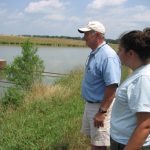2008 – AUHP – Bloom-chasing: Establishing a monitoring network for toxic cyanobacterial blooms in Alabama’s freshwater systems

Funding: Auburn University Hatch program - $50,000
Duration: October 2008 - September 2010
Collaborators: Jim Stoeckel (co-PI, Auburn University)
Product: models useful for forecasting algal and cyanobacterial blooms

Models to forecast freshwater algal and cyanobacterial blooms
The following spreadsheet contains two models useful for water resource managers, lake owners, and researchers to forecast algal, cyanobacterial (blue-green algal), and toxic cyanobacterial blooms in lakes, ponds, and reservoirs. The models incorporate either Secchi depth (measured in meters) or commonly measured water quality parameters, such as chlorophyll a or total phosphorus concentrations, to predict algal blooms and their associated water quality risks. The current spreadsheet incorporates data from 103 waterbodies across Alabama that vary widely in morphology, mixing regime, flow, and nutrient concentrations sampled during the summers of 2008-2009. We are currently evaluating the utility of these models for sites throughout the Southeast. We will update the models, as well as provide alternative models specific for certain types of water bodies, in the future. Please use the models and let us know if they are useful for you and/or if you have any questions, comments, or concerns about the models.
Available forecasting models
1. General use Secchi depth model (ideal for homeowners and general public)
2. Complex water quality model (ideal for water quality managers, state agency scientists, and academics)
Website development and coding – Mark Bransby